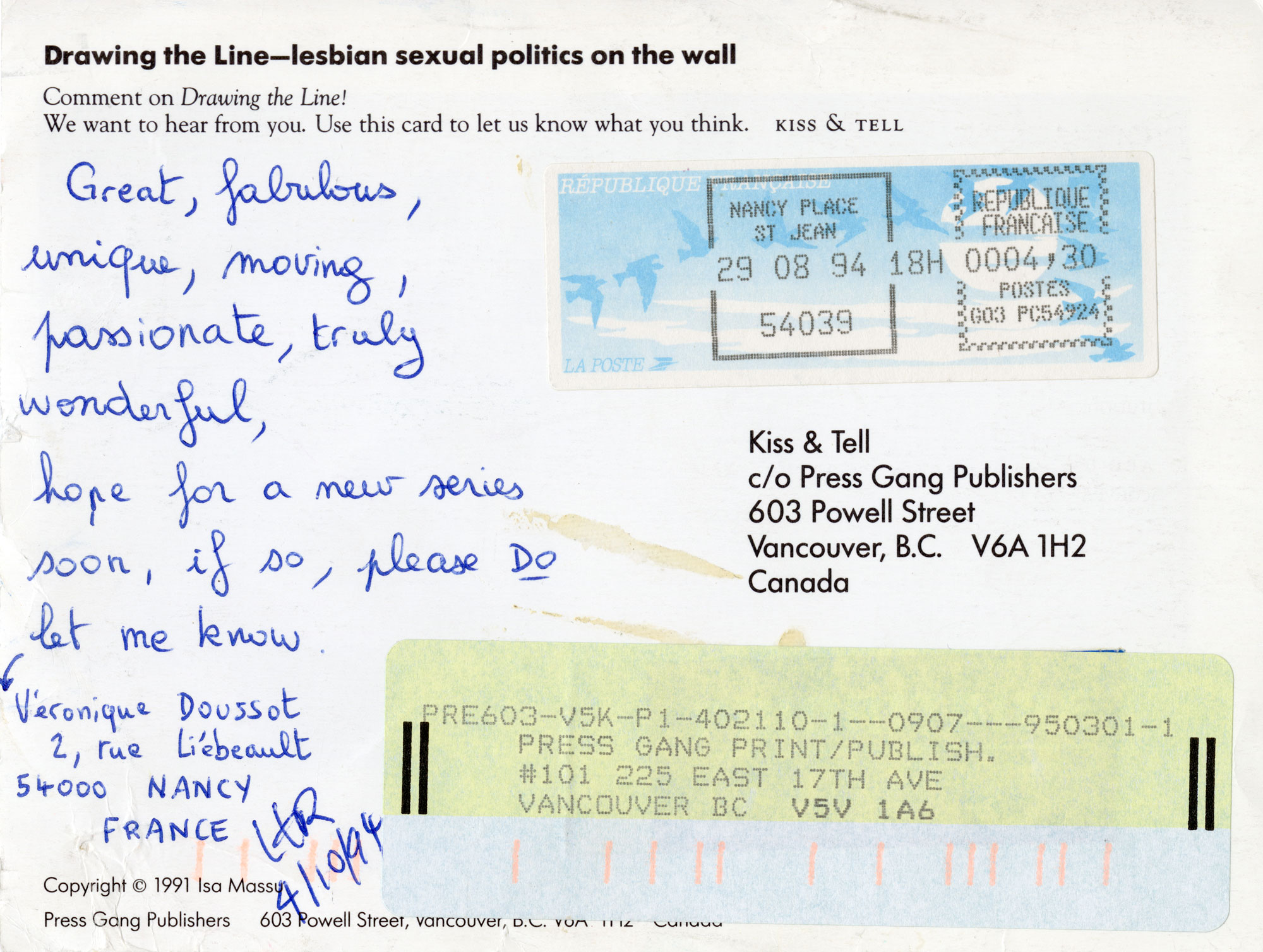Drawing the Line: Lesbian Sexual Politics on the Wall Postcard book 1991

Kiss & Tell, Drawing the Line: Lesbian Sexual Politics on the Wall postcard book, 1991
Simon Fraser University Library Special Collections and Rare Books, Burnaby
The image above is an example of a mail-in response from a viewer who attended Kiss & Tell’s exhibition Drawing the Line.
Inspired to create a companion piece to Drawing the Line, 1988–90, to reach a larger audience, Kiss & Tell selected forty photographs from the exhibition and made them into a postcard book titled Drawing the Line: Lesbian Sexual Politics on the Wall. The introduction set out their intentions: “By using the same [two] women in all the pictures we attempted to limit the judgments to being about what the models are doing and how they are depicted…. Drawing the Line is a collaboration between women who have built trust over an extended period of time. It is our history together that let us explore the often scary dynamics in explicit sexual photography.”
Select comments from exhibition walls were included on the backs of the postcards. In response to one photograph of the two women nude in bed, in a seeming moment of orgasm, viewers from Los Angeles, Toronto, and Vancouver wrote: “I want to do it, not to look at it. It’s a skin thing for me,” “Was inspired to try this out. It’s wonderful but hard on bad backs,” and “Looks like the decisive moment to me!” Kiss & Tell didn’t shy away from including criticisms and negative comments in the book. The point of the project was to foster dialogue that included differing voices and opinions. For example, one viewer in Melbourne wrote: “Role playing = power = men = boring.” Another in Toronto commented: “I understand your reasons for only using two models, but I still want to see my coloured face here.”
-
Kiss & Tell, Drawing the Line: Lesbian Sexual Politics on the Wall postcard book, 1991
Kiss & Tell Fonds, Special Collections and Rare Books, Simon Fraser University Library, Burnaby
-
Viewer response to Drawing the Line exhibition, August 1991
Kiss & Tell Fonds, Special Collections and Rare Books, Simon Fraser University Library, Burnaby
-
Viewer response to Drawing the Line exhibition, August 1991
Kiss & Tell Fonds, Special Collections and Rare Books, Simon Fraser University Library, Burnaby
The final postcard in the book, photographed by Isa Massu in 1991, featured a woman writing on the walls of the San Francisco exhibition. This postcard could be removed from the book and mailed back to Kiss & Tell. Erin, who sent hers back from California, wrote, “What we do is fall in love with women. Sure, we do. It is so much harder to say we are sexual with women and yikes! We do some awfully good & dirty & sexy things. Love is out of the closet, how about sex? I’m tired of doing it in the dark.” Erica and Sally from Truro, Massachusetts, wrote, “We’re baffled by the images of S&M. Why perpetuate this dehumanizing, prototypically male form of ritualized violence in our own love relationships? Why are these practices (S/M) so prevalent among women who purportedly love women?” Most commentators who sent in postcards focused on how affirming it was to see these images and expressed a desire to view the entire series and have the exhibition travel to their city.
The postcard book significantly broadened the audience for the project and was another tactic by Kiss & Tell to bring images of lesbian sexuality created by women into the public sphere. With it, the collective blurred the line between high and low art by transforming analogue black-and-white photographs into a commercially available form of mail art. Photographs could be sent through the post, putting lesbian imagery into the hands of postal workers and others. On one returned postcard, a woman wrote: “I have wanted images in which I could recognize the love and lust I feel for my lover. For a while I felt that it was impossible to capture lesbian passion visually…. Here you have given me what I’ve been searching for. Thank you.” This new method for disseminating Kiss & Tell’s work also led to new restrictions: copies of the book were denied entry from the U.S. by Canada Customs, even though the work was published in Canada.

 About the Author
About the Author
 More Online Art Books
More Online Art Books
 Acknowledgements
Acknowledgements